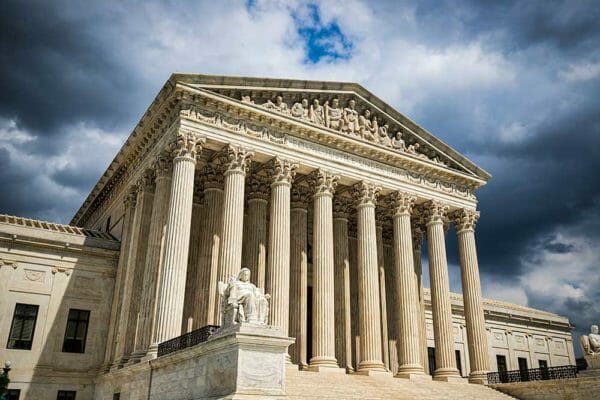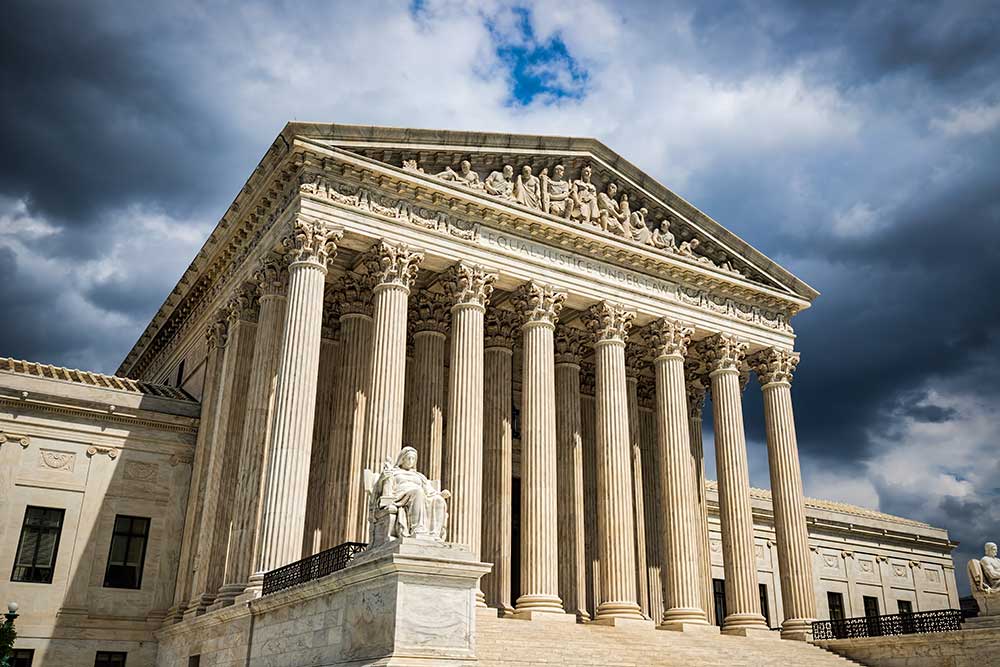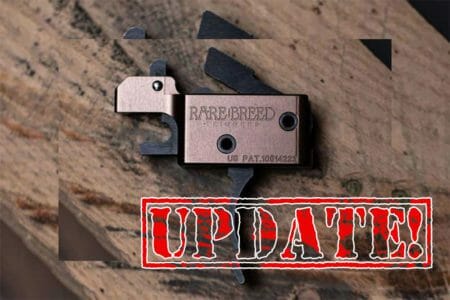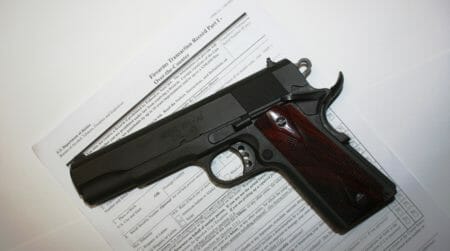
Today, the Supreme Court heard oral arguments that will determine the legality of companies selling unfinished frames that help Americans make privately manufactured firearms (PMF).
The case, Vanderstok v. Garland, was brought in the Northern District of Texas by the Firearms Policy Coalition and Blackhawk Manufacturing Group (d/b/a 80 Percent Arms)after the Bureau of Alcohol, Tobacco, Firearms and Explosives (ATF) implemented rules that reclassified incomplete unserialized frames as firearms, reversing many years of ATF opinion letters. The change after President Joe Biden ordered the ATF to change the rules after he was unsuccessful in getting a bill to ban what he referred to as “ghost guns.”
A Federal District Court judge knocked down the law, stating that the ATF violated the Administrative Procedures Act (APA). The federal government would then appeal to the United States Fifth Circuit of Appeals. The defendants argued that the lower court made the decision wrong and that the ATF was within its authority to change regulations. They claimed these firearms are leading to an “epidemic of gun violence” even though federal stats combine the number of crimes committed with PFMs with the number committed with guns with obliterated serial numbers.
The Fifth Circuit sided with the lower court and upheld the District Court’s decision. The federal government would ask the Supreme Court to stay the Fifth Circuit’s decision to enjoin the ATF from enforcing the rule. SCOTUS would grant the ATF an administrative stay on the injunction until the government could file for a writ of certiorari with the high court. The Supreme Court would grant cert, meaning they chose to review the case.
Since the rule was passed, SCOTUS has decided on two major cases that directly affected the ATF’s rule-making ability. The first case was Cargill. That case was also from the Fifth Circuit Court of Appeals. It dealt with the ATF creating a rule reclassifying bump stocks as machine guns. The ATF used many of the same reasons to claim it had the power to make rules with the force of law, effectively bypassing Congress. SCOTUS ruled by a 6-3 margin that the bump stock rule violated the APA, and the ATF exceeded its authority.
Loper Bright Enterprises is the second Supreme Court case that will impact the Vanderstok case. That case dealt with Chevron deference. Chevron stated that if a law is unclear, the regulatory agency gets to determine what the law means. In Loper Bright Enterprises, SCOTUS struck down Chevron, removing one of the ATF’s weapons to defend its rules.
The ATF started by arguing that it did not change the statutory definition of a firearm. The ATF claimed that these items are readily convertible. The government lawyer contended that the rule was needed because companies sold unfinished frames with jigs and drill bits. Justice Samual Alito seemed doubtful of the government’s argument and asked if a pen and a piece of paper should be considered a grocery list.
Justice Neil Gorsuch asked about the ATF’s classification of the unfinished frames as firearms. The ATF pushed back, stating they were firearms because the frames were readily convertible. Gorsuch pushed back by asking about the ATF’s filing in a Syracuse, New York case where the ATF stated that an unfinished frame wasn’t a firearm. The government said the respondents misread the filing. Gorsuch didn’t seem convinced.
Justice Alito asked about what type of time it makes something readily converted. The ATF stated that the longest time for something to be readily convertible is eight hours. Alito didn’t seem to agree with the ATF, and that bodes well for gun owners.
Judge Elena Kagan asked if the rule affected gun smiths’ buying firearm parts. The defendant stated that gun smiths wouldn’t be affected. The ATF said they are only targeting “fringe vendors.” The lawyer noted that it only stops companies from selling items that people can use to create firearms by using tools such as dog grooming products.
Justice Brett Kavanaugh stated that he is worried about expanding the criminal statute. The ATF said that if a person was unaware of the regulation, they could not be criminally charged. Kavanaugh pushed back and asked about a possible charge for not running background checks. The ATF admitted that the person could still be arrested and prosecuted for failing to run the background check.
Justice Amy Comey Barrett asked the ATF since AR15s could be readily convertible to machine guns by drilling a single hole should people be concerned that the ATF might try to regulate AR15s as machine guns. The ATF said since an AR15 is a stand-alone item that, the ATF would never classify an AR15 as a machine gun.
Justice Ketanji Brown Jackson was concerned that the courts were trying to overrule the government agency’s authority. The ATF agreed with Justice Jackson. Instead of asking questions, Jackson went into a monolog as to why the ATF has the power to regulate unfinished frames. It seemed like she was advocating the return of Chevron deference. The ATF stated that a facial challenge could only be made if the law conflicts with the Gun Control Act of 1968 and believes the rule falls well within the law.
Justice Clarence Thomas asked about the 80% rule. The plaintiff highlighted that “80%” is only a colloquial term. The plaintiffs said the law says to look at the item, not the summary of parts. Justice Thomas appeared open to the plaintiff’s ideas. It seemed clear as to which way he would vote.
Justice Sonia Sotomayor seemed hostile towards the plaintiffs. She asked if removing a single plastic tab would exempt an unfinished frame from being a firearm. The plaintiffs said the kits are on the market and need much more done than just removing a tab. She didn’t seem happy about the response.
Justice John Roberts asked about the ATF’s critical machining operations test to the plaintiffs. The plaintiffs said the critical machining operations test says it is not a finished frame until the final hole is at least indexed. Justice Roberts seemed to be on the fence about how he will vote. He or Barrett could be the deciding vote.
In their rebuttal, lawyers for the ATF closed by stating the only purpose of a “ghost gun” is to be used for nefarious purposes. The ATF’s lawyer dismissed plaintiffs’ claims that hobbyists buy these products to build their own firearms. She said the major gun manufacturers not suing the ATF over unfinished frames shows the criminal element in the DIY gun industry, even though the vast majority of builders are law-abiding citizens. One of the plaintiffs, 80 Percent Arms, gave AmmoLand News a statement.
“We’ve stood on the front lines of this fight because it’s about more than just stopping flawed regulations—it’s about defending the fundamental freedoms that the Constitution guarantees,” 80 Percent Arms said in a released statement to AmmoLand News. “If the ATF’s overreach is allowed to stand, it could lead to even more aggressive attempts to restrict your rights. Even the government’s own recent letter to the Court indicates they know this case isn’t as clear-cut as they want you to believe.”
The Court will not reveal the decision for a few more months. If past cases are any indication, the ATF rule on unfinished frames might be on its deathbed. The decision will ride on Justice Barrett and Justice Roberts opinion. If the frame rule fails, the death of the pistol brace rule will not be far behind.
About John Crump
Mr. Crump is an NRA instructor and a constitutional activist. John has written about firearms, interviewed people from all walks of life, and on the Constitution. John lives in Northern Virginia with his wife and sons, follow him on X at @crumpyss, or at www.crumpy.com.







Here’s the solution: F the ATF.
Barrett’s been a disappointment on countless cases. Robert’s, for being a Republican appointee, seems to side with the tyrants more often than not.
After hearing the oral recording, don’t be surprised if SCOTUS sides with BATF on this one. Despite some minor kickback from supportive justices, the tone of the hearing leaned towards the BATF. This is just another case where we let things slip through our fingers. Instead of passing clear and concise legislation, we kicked the can into SCOTUS’s yard… again. For some reason we keep believing that SCOTUS is our bastion of safety. Yet we continually ignore the fact that SCOTUS is a single POTUS away from unraveling decades of hard won 2A recognitions. I pray I am forced to… Read more »
The ATF has no authority to make laws , that’s what congress does . These over reaching clowns need to be fired and the whole damn alphabet soup agency disbanded .
I still don’t understand why this is being challenged. Shall not be infringed means that the federal government cannot stop us from having gun ownership. There is no limitations stated on what type of gun we can or cannot have.
The 1934 firearms act and the act in 1968 are both newer and not as old as the constitution and 2nd amendment, therefore under Bruen, this whole scam is pointless and should not be allowed to be challenged. In addition the two acts should also be abolished. I don’t understand why they haven’t been yet!!!
Oregoneistan
WTF Trump 2024
since when does a federal agency get to make up rules at the whim of a deranged president? of anyone for that matter.
I think we all know that the Justices are not all well educated on the topic at-hand. However, I sure hope the 2A lawyers drive home the point that the ATF position is based on buying a “kit”, a single sku item. 2A lawyers can try and win their position, but at the same time they need to use words and arguments that make it very clear, if SCOTUS makes the wrong decision and sides with ATF, then the ruling should be clear that it’s for single sku “kits” only. If all the kit parts are sold as separate sku’s… Read more »
This is a disappointing article. Not because it doesn’t proclaim a certain victory but because it is positive spin on a mediocre performance by the plaintiff’s lawyer and a stellar one on the part of the government. The plaintiff’s lawyer did not point out that the argument over criminal misuse was interest balancing. He failed to point out that a criminal breaking into a house and stealing a gun before committing a crime with it is no more traceable than using a PMF. He did not or poorly countered the governments description of how easy it was to make a… Read more »
>The ATF said they are only targeting “fringe vendors.”
The ATF will target every gun owner they can when ever they can get away with it.
As to the part about coversion of AR-15’s to machine guns, we need to stop villifying machine guns. They are a wonderful invention if you need firepower. We need to make SCOTUS rule on the basis of what a weapon is as covered in the 2nd Amendment and what infringement is. If they get it wrong, then it is revolution time.
HLB
I ABSOLUTELY REBUT the following “argument” that the ATF Bureaucrats’ ‘lawyer’ stated!
“In their rebuttal, lawyers for the ATF closed by stating the only purpose of a “ghost gun” is to be used for nefarious purposes. The ATF’s lawyer dismissed plaintiffs’ claims that hobbyists buy these products to build their own firearms. She said the major gun manufacturers not suing the ATF over unfinished frames shows the criminal element in the DIY gun industry, even though the vast majority of builders are law-abiding citizens.”
WHAT A FREAKING LIAR!